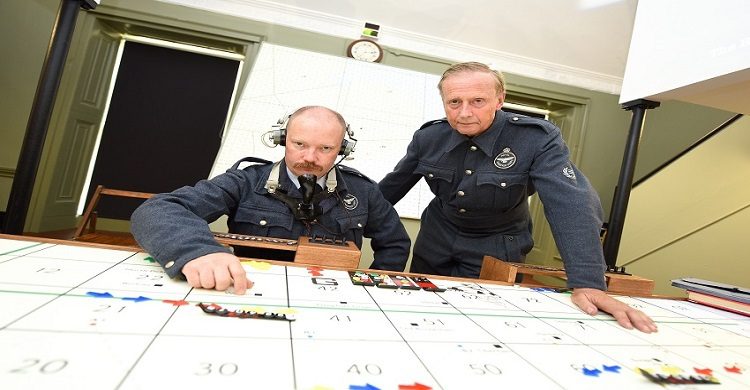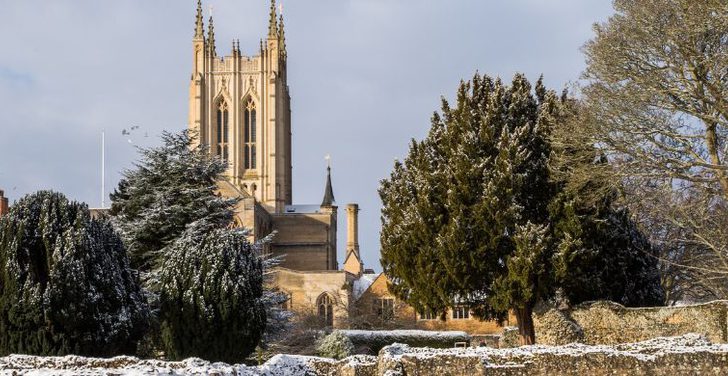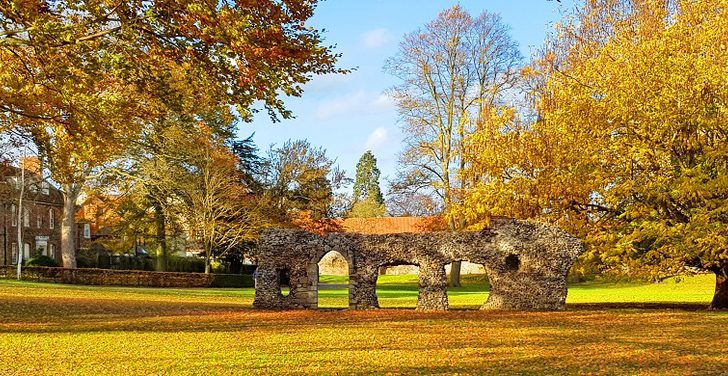
Back to Blogs
Discover
Discover The Battle of Fornham
By Dan Clarke, Heritage Officer at Moyse's Hall Museum
Under the Banner of Saint Edmund: The Battle of Fornham

The Fornham Sword on display at Moyse's Hall Museum
The largest known conflict seen near Bury St Edmunds was the ‘Battle of Fornham’, fought across land that includes or borders the villages of Fornham St Genevieve, Fornham All Saints, and Fornham St Martin.
The battle was fought on 17th October during the Revolt of 1173-74. The Revolt was a complex family feud - full of ego and greed; modern soap operas take note!
It should be noted that this is one of the most complex of feuds in the history of a country full of convoluted conflicts, many aspects of what follows are open for debate.
It has been argued that the Revolt occurred as a result, in part or in total, of Henry II’s decision to offer three castles to his youngest legitimate son John as part of an inheritance to secure his son’s marriage to the daughter of the Count of Maurienne. This undermined the claim of Henry the Young, the king’s eldest legitimate son, as the three castles chosen were on land that would have formed part of his inheritance.
The fallout of this decision would lead to Henry II’s eldest three legitimate sons, Henry, Richard (later ‘The Lionheart’), and Geoffrey, withdrawing to the court of Louis VII and raising a rebellion against their father. Louis was Henry the Young’s father-in-law and encouraged the rebellion along with other nobles who would profit from a transfer of power to the would-be usurper.
The brothers were also aided by their mother, Eleanor of Aquitaine, wife of Henry II, who joined the cause along with many others who were horrified by the King’s possible involvement in the martyrdom of Archbishop Thomas Beckett in 1170, an event which sent shockwaves throughout the Christian world.

Swords on display in 2023
The revolt began in April 1173 and would lead to battles throughout the Angevin Empire in England and Normandy. The endeavour was for Henry the Young and Louis VII to aggressively take the formers inheritance and then, perhaps ironically, give land and revenues of it to those nobles who supported the move.
Louis and Henry the Young secured many allies and were confident enough to invade Normandy while Scotland invaded England from the north. These invasions failed, as did the peace talks that followed, which led to further conflict.
October 1173 saw the revolt reach our Suffolk borders. Robert de Beaumont, 3rd Earl of Leicester, invaded England with an army of Flemish mercenaries, landing at Walton, Suffolk. Leicester took his forces to Framlingham where he joined Hugh Bigod, 1st Earl of Norfolk. Bigod was a keen supporter of Henry the Young having been promised the custody of Norwich Castle if the rebellion was victorious.
Robert de Beaumont’s next step was to move his army to his home base of Leicester, with the motive for this being up for debate. One possibility is the need for reinforcements due to fighting with the King’s forces weakening their hold. However, another interesting suggestion is that Leicester had to move on due to frustrations or squabbling with Bigod and his wife, Gundreda, who herself was of the de Beaumont bloodline.
Leicester’s forces were cut off as they were fording the River Lark, and while split between banks were easier prey for supporters of Henry II who rode under the banner of St Edmund, backed by our Abbey. The King’s supporters took the victory and captured Leicester.

Swords on display at Moyse's Hall Museum in 2023
There are two swords found at the battle site that can be seen in Bury St Edmunds.
The first is on display Moyse’s Hall Museum on permanent loan from the MacRae family who owned the land it was found upon. From the battlefield the Museum also has a dagger and spear, as well as arrowheads and bolts of the period to give a sense of the scene itself.
The second sword is on display at All Saints Resort close to where it was found, with their café overlooking the beautifully kept battlefield.
An exhibition at the Museum in 2023 was the first time that the swords were ever displayed side-by-side.
Two rings were also found near the battle site on land near the River Lark. There is a story about Petronilla, wife of the captured Earl of Leicester, who cast a ring into the mud and went into the water. It has been suggested that if true she was trying to drown herself in defeat. While unlikely to be her ring, these two pieces offer a chance to contemplate a moment of humanity within a narrative largely lost to inhuman facts and dates. One is a stunning Roman ring, which, it has been suggested, may have been reused during the Medieval period. The other is probably too late for the battle but nonetheless a beautifully inscribed gold medieval ring.
Related Blogs

News
Town’s Museum Forms New…
Moyse’s Hall Museum will be forging links with a…

News
St Edmundsbury Cathedral…
St Edmundsbury Cathedral in Bury St Edmunds is…

News
Bury St Edmunds & Beyond…
Step inside many of Bury St Edmunds historic buildings…

News
Bury's Best Pubs with a Past
some notable, historic and somewhat quirky pubs and…

News
UnLondon in Bury St Edmunds
Escape the rat race and hop on board with Greater…
Latest news

News
Festive Markets in Bury St Edmunds
Festive markets are set to bring seasonal cheer to Bury St Edmunds this November and December, offering the perfect chance to pick up all of your Christmas essentials!

News
Savour The Winter Season in Bury St Edmunds
Ways to mark the winter season in Bury St Edmunds

News
Where to see fireworks in and around Bury St Edmunds
If you're visiting Bury St Edmunds around bonfire night here’s our roundup of some of the best celebrations in Bury St Edmunds and the surrounding towns and villages.

News
Town’s Museum Forms New Partnership with US Museum
Moyse’s Hall Museum will be forging links with a museum in Salem Massachusetts as part of a project to explore the shared history of the infamous witch trials.

News
Bury St Edmunds Comedy Festival 2026 Line-Up
The 2026 line-up includes Jason Manford, Luke Wright, Pauline Eyre and Daliso Chaponda!

News
Enjoy two months of rib-tickling fun at Comedy Festival
Bury St Edmunds third Comedy Festival will bring two months of rib-tickling, laugh out loud fun to Suffolk during funny February and March 2026.

News
Autumn in Bury St Edmunds
From pumpkins to falling leaves and from ghost stories to trails, this is the only guide you'll need this autumn in Bury St Edmunds!

News
Tea with a View
Whether it's the hustle bustle of people watching, a breath-taking vista or the wonder of a historic setting, there are plenty of captivating places for tea with a view in Bury St Edmunds and beyond.

News
St Edmundsbury Cathedral Launches 2026 Dogs in the Cathedral Calendar
St Edmundsbury Cathedral in Bury St Edmunds is celebrating being a dog-friendly Cathedral once again with the launch of the 2026 Dogs in the Cathedral Calendar.
